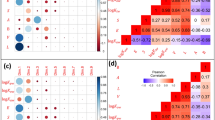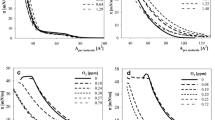Abstract
The ability of a range of organic pollutants-hexachlorobenzene, mirex(1,1a, 2,2,3,3a,4,5,5,5a,5b,6-dodecachlorooctahydro-1,3,4-metheno-1H cyclobuta(cd) pentalene), 1,3,5-trichlorobenzene, 2,4,6-trichlorophenol,p-nitrophenol,p-chlorophenol, DDT, and pentachlorophenol to perturb liposomes of dipalmitoyl phosphatidylcholine (DPPC) has been measured by differential scanning calorimetry. The degree of perturbation was measured by the increase in breadth of the main DPPC phase transition in both heating and cooling scans. DDT and the phenol derivatives were effective perturbers of phospholipid, broadening the transition by as much as 12-fold. Hexachlorobenzene and mirex did not perturb at all when mixed with DPPC at concentrations as high as 20 mol%, although 1,3,5-trichlorobenzene caused slight broadening of the main transition at this concentration. Perturbation is facilitated by the presence of a hydroxyl group on the benzene ring and hindered by increasing degrees of chloride substitution. An apparent correlation exists between the extent of phospholipid perturbation measured by differential scanning calorimetry and LD50 values for these compounds taken from the literature. This suggests the possibility of formulating an “index of perturbation” which could be used to screen certain classes of organic compounds for potential biological toxicity on a routine basis.
Similar content being viewed by others
References
Bangham, A. D.: Lipid bilayers and biomembranes. Annu. Rev. Biochem.41, 753 (1972).
Colley, C. M., and B. E. Ryman: The use of a liposomally entrapped enzyme in the treatment of an artificial storage condition. Biochim. Biophys. Acta451, 417 (1976).
De Kruyff, B., R. A. Demel, and L. L. M. Van Deenen: The effect of cholesterol and epicholesterol incorporation on the permeability and on the phase transition of intactAcholeplasma laidlawii cell membranes and derived liposomes. Biochim. Biophys. Acta255, 331 (1972).
Demel, R. A., J. W. C. M. Jansen, P. W. M. Van Dijck, and L. L. M. Van Deenen: Preferential interaction of cholesterol with different classes of phospholipids. Biochim. Biophys. Acta465, 1 (1977).
Dittmer, J. C., and M. A. Wells: Quantitative and qualitative analysis of lipids and lipid components. Methods in Enzymol.14, 482 (1969).
Grant, C., and H. McConnell: Fusion of phospholipid vesicles withviable Acholeplasma laidlawii. Proc. Natl. Acad. Sci. U.S.A.70, 1238 (1973).
Gregoriadis, G.: The carrier potential of liposomes in biology and medicine. N. Engl. J. Med.295, 765 (1976).
Hinz, J. H., and J. M. Sturtevant: Calorimetric investigation of the influence of cholesterol on the transition properties of bilayers formed from synthetic L-α-lecithins in aqueous suspension. J. Biol. Chem.247, 3697 (1972).
Juliano, R. L., and D. Stamp: The effect of particle size and charge on the clearance rates of liposomes and liposome encapsulated drugs. Biochem. Biophys. Res. Commun.63, 651 (1975).
Kimelberg, H. K., and M. A. Atchison: Effects of entrapment in liposomes on the distribution, degradation and effectiveness of methotrexatein vivo. Ann. N.Y. Acad. Sci.308, 395 (1978).
McKersie, B. D., and J. E. Thompson: Influence of plant sterols on the phase properties of phospholipid bilayers. Plant Physiol.63, 802 (1979).
Rahman, Y. E., M. W. Rosenthal, and E. A. Cerny: Intracellular plutonium: removal by liposome-encapsulated chelating agent. Science180, 300 (1973).
Ryman, B. E., R. S. Jewkes, K. Jeyasingh, M. P. Osborne, H. M. Patel, V. J. Richardson, M. H. N. Tattersall, and D. A. Tyrrell: Potential applications of liposomes to therapy. Ann. N.Y. Acad. Sci.308, 281 (1978).
Tyrrell, D. A., T. D. Heath, C. M. Colley, and B. E. Ryman: New aspects of liposomes. Biochim. Biophys. Acta457, 259 (1976).
Author information
Authors and Affiliations
Rights and permissions
About this article
Cite this article
Packham, E.D., Thompson, J.E., Mayfield, C.I. et al. Perturbation of lipid membranes by organic pollutants. Arch. Environ. Contam. Toxicol. 10, 347–356 (1981). https://doi.org/10.1007/BF01055636
Received:
Accepted:
Issue Date:
DOI: https://doi.org/10.1007/BF01055636




